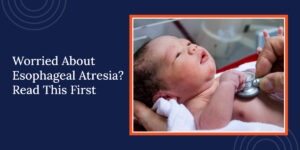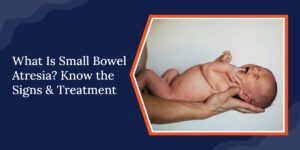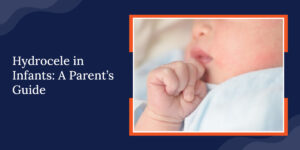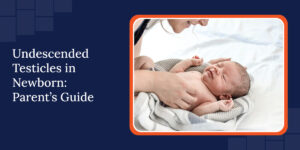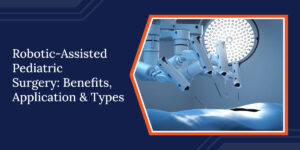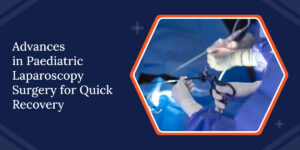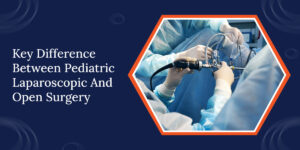Have you ever noticed a little bump on your baby’s tummy and wondered if it’s just gas, a muscle spasm or something more? That unexpected lump can be scary, but it’s more common than you think. In many cases, it’s an infant hernia, a condition where a bit of tissue pokes through a weak spot in the abdominal muscles. The word ‘hernia’ can sound concerning, but most are treatable and sometimes even resolve on their own. In this blog, we will look at the symptoms, types of hernia, and when seeking medical advice, which is key to getting your baby the right care.
A] Understanding Infant Hernia
An infant hernia occurs when a part of an internal organ, like the intestine, pushes through the weak spot in the abdominal muscles. This bulging is more noticeable when the baby cries, coughs or strains and may disappear when calm or lying down. Though it might seem alarming, most infant hernias are harmless when identified early and treated correctly.
There are different types of hernias:
- Inguinal Hernia: It is the most common type of hernia in babies and occurs in the groin or extends all the way into the scrotum or labia. They occur in about 1 to 5% of infants and children. They are common in boys and premature babies due to underdeveloped abdominal muscles.
- Umbilical Hernia: This type of hernia develops where the umbilical cord was once attached to the navel. They usually occur when the muscles around the belly button do not close after the leftover umbilical cord falls off after birth. This type of hernia is more frequent in full-term infants, especially African American babies, and often closes on its own by the age of 3 or 4.
Other rare types of hernia include Epigastric Hernia, which develops in the upper abdomen between the breastbone and the belly button and Incisional Hernia, which can occur after surgery if the surgical wound doesn’t heal properly.
Is Your Baby at Risk? Learn About Infant Hernia Now!
B] Causes and Risk Factors Of Hernia In Infants
Hernia in babies is often caused by congenital factors where natural openings in the abdominal wall don’t close properly before birth. However, several risk factors can increase the chance of a baby developing a hernia.
Common causes
- Congenital Weakness: Some babies are born with weak spots in their abdominal wall, making them more prone to hernia.
- Premature Birth: Premature babies have underdeveloped muscles, which makes them more vulnerable to infant hernias.
- Failure of Natural Closure: In boys, if the inguinal canal doesn’t close completely after the testicles descend, it can leave a weak spot where a hernia may form.
Risk factors
- Gender: Boys are more likely to develop inguinal hernias due to differences in fetal development.
- Family History: The risk increases if parents or siblings have had hernias.
- Low Birth Weight: Babies with lower birth weights often have weaker abdominal muscles.
- Certain Medical Conditions: Disorders like cystic fibrosis or connective tissue issues can increase the risk.
- Chronic Coughing or Straining: Frequent strain from constipation or chronic cough can pressure weak abdominal areas.
C] How To Notice The Symptoms of Infant Hernia?
Identifying what are the symptoms of a hernia in a child can make a big difference in early detection and treatment. The most common symptom is a soft bulge or swelling in the groin (inguinal hernia) or around the belly button (umbilical hernia). The bulge often becomes more prominent when the baby cries, coughs or strains and may flatten when calm or lying down.
While most hernias in children are painless, some signs may indicate complications:
- Persistent swelling that doesn’t go away when gently pressed.
- Redness, tenderness or warmth around the bulge.
- The baby seems irritable, cries more than usual or refuses to eat.
- Vomiting or a bloated belly can be a sign of a trapped hernia (incarcerated hernia).
If the abdomen is swollen or tender, it can be a sign of incarceration or strangulation of the hernia and needs to be seen urgently. In such cases, paediatric hernia surgery is crucial to minimise risks and protect your baby.
D] How Is Infant Hernia Diagnosed?
Diagnosing a hernia in babies is a straightforward process that starts with a physical examination. A doctor will examine the bulge carefully and ask if it gets more prominent when the baby cries, coughs or strains. During the exam, the doctor will gently press on the bulge to see if it can be pushed back into the abdomen—a process called reduction.
Most of the time, a physical exam is enough to confirm the diagnosis. However, if the hernia is not visible or complications are suspected, imaging tests like an ultrasound may be done to better view the hernia and surrounding tissues. This rules out conditions like incarceration or strangulation, which need urgent care. Early diagnosis is key to deciding on the best hernia treatment for children and babies and to prevent emergencies.
E] Treatment Options for Infant Hernia
The approach to hernia in children depends on the type, size and severity of the hernia. Early evaluation by a paediatrician ensures the best course of action for your child.
Watchful Waiting
Doctors often recommend a “wait and see” approach for small, painless umbilical hernias. These hernias usually close on their own when a child is 3 or 4 years old. During this period, regular check-ups help monitor the hernia and ensure no complications arise.
Surgical Intervention
Inguinal and larger umbilical hernias that don’t close naturally will require surgery. Pediatric hernia surgery is a safe and routine procedure where the surgeon will put the bulging tissue back in place and reinforce the abdominal wall. Recovery is usually smooth, but following the pediatric surgeon’s post-operative care instructions is crucial for quick and complication-free healing.
Many parents worry about recovery after baby hernia surgery, but babies heal fast and can go back to normal activities in a few days. Dr. Bhushanrao Jadhav, a trusted paediatric surgeon in Dubai, offers expert care and tailored treatment plans to ensure the best outcome for your little one.
Is Your Baby at Risk? Learn About Infant Hernia Now!
F] How Can Infant Hernias Be Prevented?
Not all hernia risk factors in children and babies can be controlled, but here are some steps you can take to reduce the chances of complications:
- Get Proper Prenatal Care: Reduce the risk of premature birth to minimise hernia risks.
- Don’t Strain: Avoid situations that cause excessive crying or constipation, which can increase pressure on the abdomen.
- Handle Babies with Care: Use proper lifting techniques to avoid putting unnecessary pressure on the baby’s tummy.
- Watch Out for Early Signs: Check regularly for swelling or bulges, especially in preterm babies or those with a family history of hernias.
Conclusion
Hernias in your baby can be worrying, but most are easy to treat and, in some cases, may even resolve on their own. The key is early detection and the right medical guidance to prevent complications and speed up recovery. With timely care, babies heal quickly and get back to normal routines without any lasting effects.
If you have any concerns about your child’s hernia or want expert advice on treatment options, Dr. Bhushanrao Jadhav is here to help. With years of experience in paediatric surgery and a personal touch, Dr. Jadhav ensures your child gets the best care. Book a consultation today for trusted guidance and complete peace of mind.

Dr. Bhushanrao Jadhav
Dr. Bhushanrao Jadhav is a highly skilled Pediatric Surgeon and Urologist specialising in minimally invasive and robotic surgeries for children. With advanced training from leading institutions in the UK, India and USA, he brings expertise in treating complex genitourinary conditions and neonatal surgical ailments. Driven by compassion and innovation, Dr. Jadhav has pioneered pediatric robotic surgery programs in Pune, India, ensuring world-class care tailored to children’s unique needs.





